The Orange-tip is widespread and common in Britain although it is local in the north of Scotland but even here numbers are said to be increasing. Generally, abundance and range have increased and expanded since the 1950s in spite of more intensive farming practices including extensive hedgerow removal on local sites. Perhaps the versatility of the females' selection of foodplants has helped in the butterfly adapting in a changing environment. Since 1976, both distribution and numbers have improved slightly. A similar situation arises in Hertfordshire and Middlesex where an upward trend in both range and abundance has materialised (Wood, 2016) although numbers have dropped slightly since the 2015-19 period.
| United Kingdom | Herts & Middx | |||
| Distribution | 1976-2019 | -1% | 1980-2015 | -14% |
| Average 10-year trend | -0.2% | 2006-2015 | +30% | |
| 2024 since 2015-19 | +3% | |||
| Abundance | 1976-2024 | +42% | 1980-2015 | -22% |
| 2015-2024 | +6% | 2006-2015 | +10% | |
| 2023-2024 | +4% | 2024 since 2015-19 | -50% | |
UK distribution map
UKBMS Species summary
The species inhabits similar haunts to the Green-veined White with a preference for woodland edges, sunny hedgerows, roadside verges and damp fields. It is also much scarcer on dry chalky soils.
Garlic Mustard Alliaria petiolata, Cuckooflower Cardamine pratensis. Other foodplants used include Hedge Mustard Sisymbrium officinale, Black Mustard Brassica nigra and Watercress Rorippa nasturtium-aquaticum (Sawford). In gardens, Honesty Lunaria annua may be used (Wood, 2016).
Honesty Lunaria annua (152), Aubretia Aubretia deltoidea (115), Cuckooflower Cardamine pratensis (75), Sweet Rocket Hesperis matronalis (73).
Evidence suggests that the Orange-tip was a common butterfly at least since Victorian times. Locally, there were probable reductions where roadside verges were cut and hedgerows removed as part of farming practice or local authority control, perhaps more so in the arable north east of the county, but as noted above the state of the butterfly has remained relatively stable.
The Orange-tip is present in every tetrad as shown on the map. The largest concentrations appear to be in the Knebworth woods complex, Fairlands Valley Park and the field north of St Nicholas Church. The highest count of 33 was recorded by Ken King on his Knebworth Park transect on 9 May 2005. In 2019, the balmy weather in February saw emergence on 24 March in a Stevenage garden, beating the previous first sighting date by seven days. Unsurprisingly, the flight season ended early with only two records in June. Numbers were slightly below average in 2023 and 2024 doubtlessly can be explained due to inclement weather in the spring.
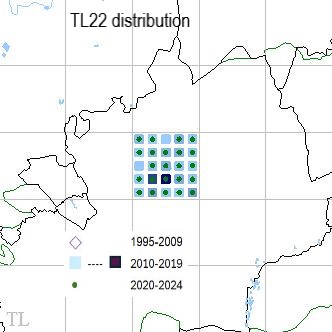
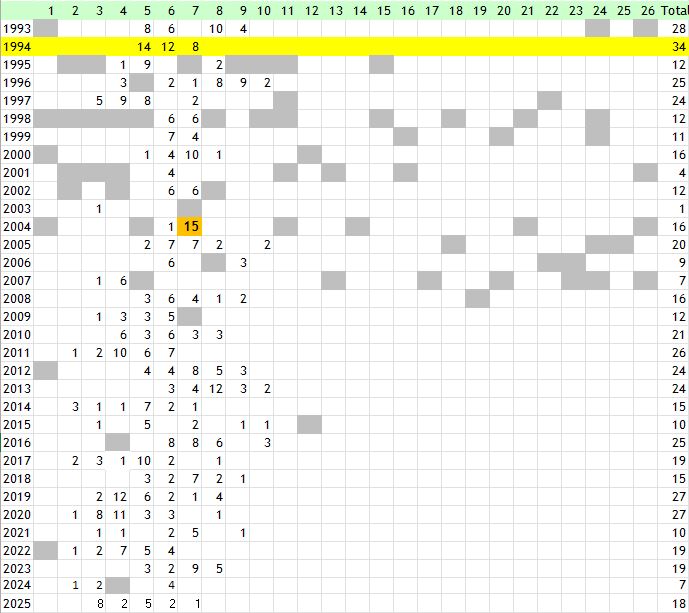
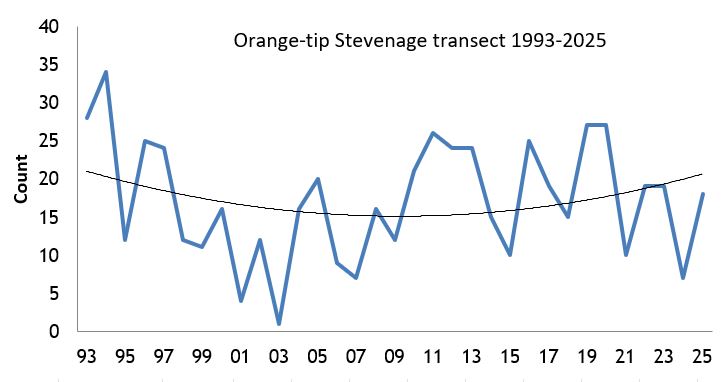
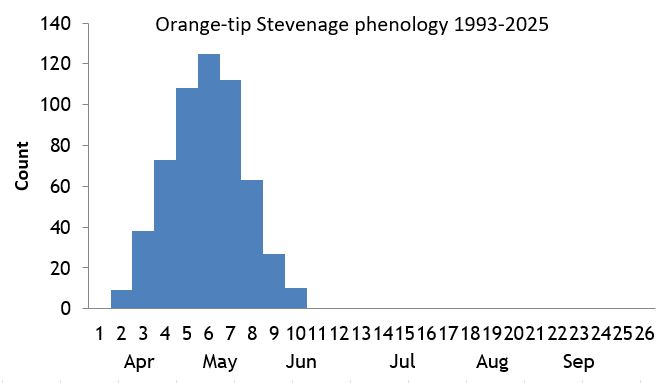


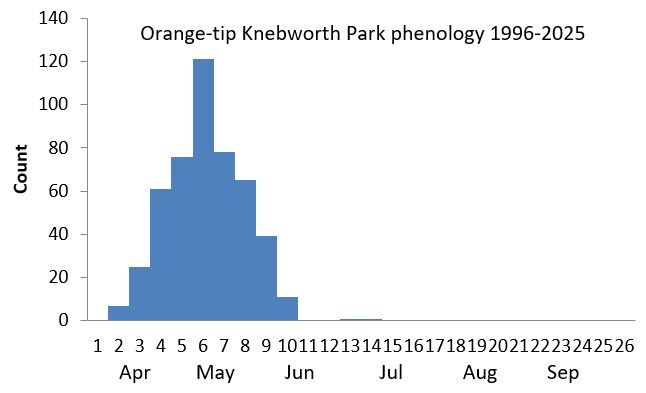

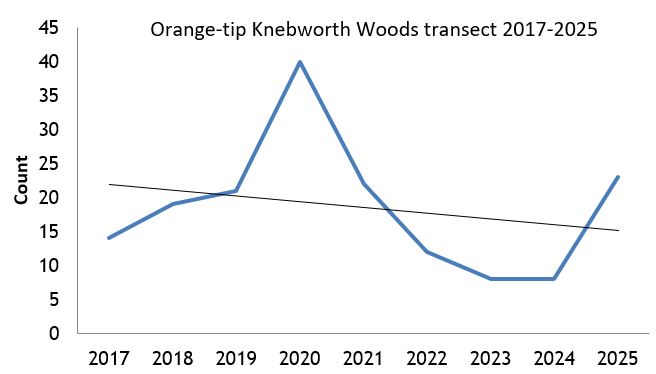
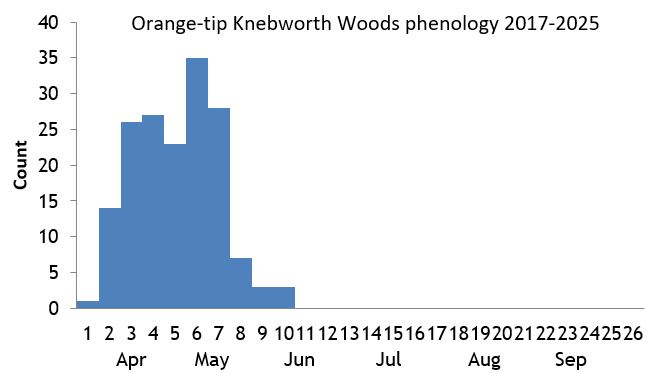
Earliest date: 24 March 2019 at Stevenage
Latest date: 6 July 2005 at Knebworth Park
The Orange Tip overwinters as a pupa
often away from the foodplant the larva was feeding on. It has been reported that a few pupae undergo diapause for more than one winter but it is unknown what
causes this. Adults usually start emerging in the middle of April and numbers hitting a peak during the second week
of May. Only one generation is produced each year but in warm summers a partial second brood may result. Although no such brood has been recorded in the
Stevenage area during the survey there are examples elsewhere in Hertfordshire. Eggs are laid singly either on the stem or on flowerheads and when they soon
turn orange, are one of the easiest eggs to find in the wild. The larvae may become cannibalistic by eating other eggs or smaller larvae on the same
plant.
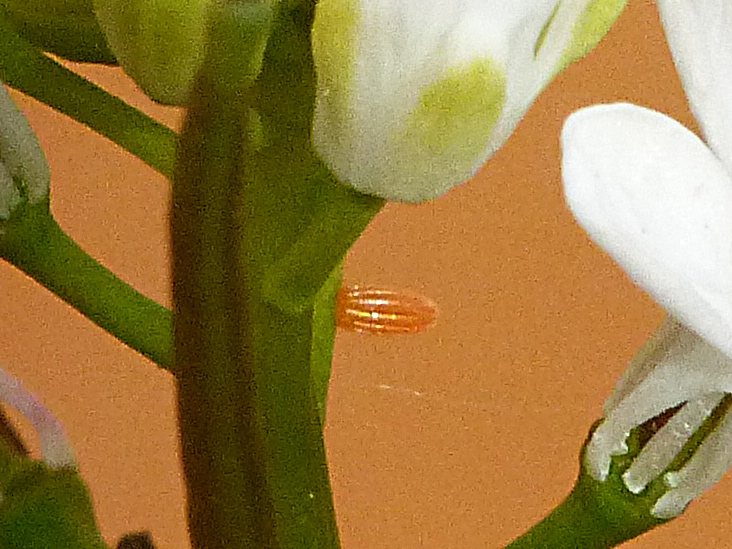
Egg Stevenage 11 May 2018

Larva Stevenage 14 May 2018

Larva Stevenage 31 May 2018
Male Orange Tips normally emerge before the females and are very active in the early stages when searching for mates. Towards the peak flight period, both sexes should be easier to approach for close-up views and particularly so earlier in the day when it is cooler (Riley).
The most common variations appear to be the nature of the discoidal spot and the colour of the tip. I found one possible aberration ab. pupillata
where the discoidal spot is pupilled but it can be argued that this example may fall within the realms of natural variation.
Find out more on the UK Butterflies website